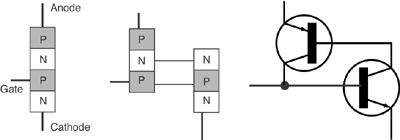Thyristor
|
|
The thyristor is a solid-state semiconductor device similar to a diode, with an extra terminal which is used to turn it on. Once turned on, the thyristor will remain on (conducting) as long as there is a significant current flowing through it. If the current falls to zero, the device switches off. Some resources define silicon controlled rectifiers and thyristors as synonymous1, while others define SCR's as a subset of thyristors2.
The thyristor is a four-layer semiconducting device, with each layer consisting of an alternately N or P-type material, for example N-P-N-P. The main terminals, labeled anode and cathode, are across the full four layers, and the control terminal, called the gate, is attached to one of the middle layers. The operation of a thyristor can be understood in terms of a pair of tightly coupled transistors, arranged to cause the self-latching action.
Thyristors are mainly used where high currents and voltages are involved, and are often used to control alternating currents, where the change of sign of the current causes the device to automatically switch off. This is known as synchronous operation or Zero Cross operation. This principle is used to control the desired loading by adjusting the frequency of the sinusoidal input. The range of frequencies is great because there is no limit to the number of cycles a thyristor can perform, and exhibits no "wear out" modes. This is a frequency domain method of control.
With phase angle control a thyristor is turned on at a specific and adjustable portion of the cycle of the controlling sinusoidal input. Moving the point at which the thyristor is turned on regulates power output. An example of this method of control is a dimmer switch for lights. The turn on point of a thyristor is controlled to occur at a particular point on the sine curve of the AC supply. The thyristor stays on for the remainder of that cycle and the longer the thyristor stays on, the brighter the light. Fine resolution of output is possible with this method and is suitable for slow-responding loads such as tungsten filament lamps or temperature variable resistance loads. Phase-angle control is also essential for inductive loads.
The drawback of a thyristor is that, like a diode, it only conducts in one direction. A similar self-latching 5-layer device, called a triac, is able to work in both directions. This added capability, though, also can become a shortfall. Because the triac can conduct in both directions, reactive loads can cause the triac to fail to turn off during the zero-voltage instants of the ac power cycle. Because of this, use of triacs with (for example) heavily-inductive motor loads usually requires the use of a "snubber" circuit around the triac to assure that it will turn off with each half-cycle of mains power. Inverse-parallel SCRs can also be used in place of the triac; because each SCR in the pair has an entire half-cycle of reverse polarity applied to it, the SCRs, unlike triacs, are sure to turn off.
Nelson_Bipole_Thyristors.JPG
An earlier gas filled tube device called a Thyratron provided a similar electronic switching capability, where a small control voltage could switch a large current. It is from a combination of "thyratron" and "transistor" that the term "thyristor" is derived.
Modern thyristors can switch large amounts of power (up to megawatts). In the realm of very high power applications, they are still the primary choice. However, in low and medium power (from few tens of watts to few tens of kilowatts) they have almost been replaced by other devices with superior switching characteristics like MOSFETs or IGBTs. One major problem associated with the thyristor is that it is not a fully controllable switch in the sense that triggering current direction needs to be reversed to switch it off. GTO (Gate Turn-off Thyristor) is another related device which addresses this problem. In high-frequency applications, thyristors are poor candidates due to large switching times arising out of bipolar conduction. MOSFETs, on the other hand, have much faster switching capability because of their unipolar conduction (only majority carriers carry the current).
Types of Thyristors
- Silicon controlled rectifier
- Distributed Buffer - Gate Turn-off Thyristor (DB-GTO)
- Triac, a bidirectional switching device containing two thyristor structures
- Gate turn-off thyristor (GTO thyristor)
- Mosfet controlled thyristor (MCT), two additional FET structures for on and off control.
- Modified anode - gate turn-off thyristor (MA-GTO)
- Static induction thyristor (SITh) or Field controlled thyristor (FCTh), a gate structure can shut down anode current flow.
References
- Dorf, Richard C., editor (1997), Electrical Engineering Handbook (2nd ed.). CRC Press, IEEE Press, Ron Powers Publisher, ISBN 0-8492-8574-1
- Christiansen, Donald; Alexander, Charles K. (2005); Standard Handbook of Electrical Engineering (5th ed.). McGraw-Hill, ISBN 0-07-138421-9
See also
et:Türistor fr:Thyristor it:Tiristore nl:Thyristor ja:サイリスタ pl:Tyrystor fi:Tyristori

